| dc.contributor.author | Amoah, N.K.A. |
| dc.contributor.author | Akromah, R. |
| dc.contributor.author | Kena, A.W. |
| dc.contributor.author | Manneh, B. |
| dc.contributor.author | Dieng, I. |
| dc.contributor.author | Bimpong, I.K. |
| dc.date.accessioned | 2022-09-15T09:01:49Z |
| dc.date.available | 2022-09-15T09:01:49Z |
| dc.date.issued | 2020 |
| dc.identifier.citation | Amoah, N.K.A., Akromah, R., Kena, A.W., Manneh, B., Dieng, I. & Bimpong, I.K. (2020). Mapping QTLs for tolerance to salt stress at the early seedling stage in rice (Oryza sativa L.) using a newly identified donor ‘Madina Koyo’. Euphytica, 216(156), 1-23. |
| dc.identifier.issn | 0014-2336 |
| dc.identifier.uri | https://hdl.handle.net/20.500.12478/7754 |
| dc.description.abstract | Salt stress is a menace to rice production and a threat to food security worldwide. We evaluated 308 F4 families from Sahel 317/Madina Koyo for tolerance to salt stress at the early seedling stage. To better understand genomic regions controlling tolerance in the population, we genotyped the progenies and the two parents using single nucleotide polymorphism (SNP) markers and regressed the genotypic data on their phenotype to detect QTLs. An average reduction of 63.4% was observed for all fitness-related traits among the F4 families. A total of 46 progenies recorded an average salt injury score (SIS) between 1–3 and were rated as tolerant to salt stress at the early seedling stage. A high-density genetic map was constructed for the 12 rice chromosomes using 3698 SNP markers. Multiple interval mapping identified 13 QTLs for SIS, shoot length, shoot dry weight and root length on chromosomes 2, 3, 4, 6, 7, 10 and 12, with trait increasing alleles coming from both parents. Two (qSDW2 and qRL2.2) and three (qSL2, qRL2.1 and qSIS2) QTLs at different regions on chromosome 2 and another two on chromosome 7 (qSDW7 and qSL7) were tightly linked. These QTLs could facilitate breeding for salt tolerance at the early seedling stage as direct selection for one, would mean indirectly selecting for the other. Fine mapping of these novel QTLs in a different genetic background is necessary to confirm their stability and usefulness in breeding for tolerance to salinity in rice. |
| dc.description.sponsorship | Bill & Melinda Gates Foundation |
| dc.format.extent | 1-23 |
| dc.language.iso | en |
| dc.subject | Rice |
| dc.subject | Seedlings |
| dc.subject | Osmotic Stress |
| dc.subject | Nucleotide Sequence |
| dc.subject | Quantitative Trait Loci |
| dc.title | Mapping QTLs for tolerance to salt stress at the early seedling stage in rice (Oryza sativa L.) using a newly identified donor ‘Madina Koyo’ |
| dc.type | Journal Article |
| cg.contributor.affiliation | Africa Rice Center |
| cg.contributor.affiliation | Kwame Nkrumah University of Science and Technology |
| cg.contributor.affiliation | International Institute of Tropical Agriculture |
| cg.contributor.affiliation | International Atomic Energy Agency |
| cg.coverage.region | Africa |
| cg.coverage.region | West Africa |
| cg.coverage.country | Cote d’Ivoire (Ivory Coast) |
| cg.coverage.hub | Headquarters and Western Africa Hub |
| cg.identifier.bibtexciteid | AMOAH:2020 |
| cg.isijournal | ISI Journal |
| cg.authorship.types | CGIAR and developing country institute |
| cg.iitasubject | Agronomy |
| cg.iitasubject | Crop Systems |
| cg.iitasubject | Grain Legumes |
| cg.iitasubject | Plant Breeding |
| cg.iitasubject | Plant Production |
| cg.journal | Euphytica |
| cg.notes | Open Access Article; Published online: 13 Sep 2020 |
| cg.accessibilitystatus | Open Access |
| cg.reviewstatus | Peer Review |
| cg.usagerightslicense | Creative Commons Attribution 4.0 (CC BY 0.0) |
| cg.targetaudience | Scientists |
| cg.identifier.doi | https://dx.doi.org/10.1007/s10681-020-02689-5 |
| cg.futureupdate.required | No |
| cg.identifier.issue | 156 |
| cg.identifier.volume | 216 |

